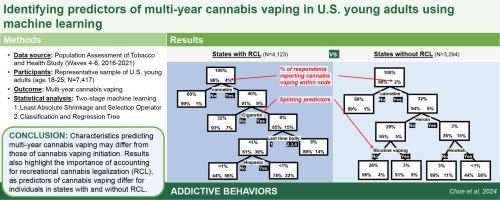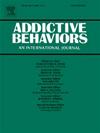Identifying predictors of multi-year cannabis vaping in U.S. Young adults using machine learning
IF 3.7
2区 医学
Q1 PSYCHOLOGY, CLINICAL
引用次数: 0
Abstract
Introduction
Increasing number of current cannabis users report using a vaporized form of cannabis and young adults are most likely to vape cannabis. However, the number of studies on cannabis vaping is limited, and predictors of cannabis vaping among U.S. young adults remain unclear. Previous studies on cannabis vaping have known limitations, as they (1) relied heavily on regression-based approaches that often fail to examine complex and non-linear interactive effects, (2) focused on examining cannabis vaping initiation but not on its use over multiple years, and (3) failed to account for recreational cannabis legalization (RCL) status.
Methods
This study was a secondary analysis of the restricted use files of the Population Assessment of Tobacco and Health Study, Waves 4–6 (December 2016-November 2021). A two-stage machine learning approach, which included Least Absolute Shrinkage and Selection Operator (LASSO) and Classification and Regression Tree (CART), was used to identify predictors of multi-year cannabis vaping while accounting for state-level RCL status among a representative sample of U.S. young adults.
Results
Stratified CART created a five-terminal-node prediction model for states with RCL (split by cannabis use, cigarette use, bullying behavior, and ethnicity) and a different five-terminal-node prediction model for states without RCL (split by cannabis use, heroin use, nicotine vaping, and hookah use).
Conclusions
Characteristics predicting multi-year cannabis vaping appear to differ from those of cannabis vaping initiation. Results also highlight the importance of accounting for RCL status because predictors of cannabis vaping may differ for individuals living in states with and without RCL.

利用机器学习识别美国年轻人多年吸食大麻的预测因素
导言目前越来越多的大麻使用者表示使用大麻汽化形式,而年轻人最有可能吸食大麻。然而,有关吸食大麻的研究数量有限,美国年轻成年人吸食大麻的预测因素仍不明确。以往关于吸食大麻的研究存在已知的局限性,因为它们(1)严重依赖于基于回归的方法,而这种方法往往无法考察复杂的非线性交互效应,(2)侧重于考察吸食大麻的开始情况,而不是其多年来的使用情况,以及(3)未能考虑娱乐大麻合法化(RCL)状况。研究采用了两阶段机器学习方法,包括最小绝对收缩和选择操作器(LASSO)以及分类和回归树(CART),以确定多年吸食大麻的预测因素,同时考虑到美国青壮年代表性样本中州一级的 RCL 状况。结果分层 CART 为有 RCL 的州(按大麻使用、香烟使用、欺凌行为和种族划分)创建了一个五终端节点预测模型,为没有 RCL 的州(按大麻使用、海洛因使用、尼古丁吸食和水烟使用划分)创建了一个不同的五终端节点预测模型。研究结果还强调了考虑RCL状况的重要性,因为对于生活在有RCL和没有RCL的州的人来说,吸食大麻的预测因素可能有所不同。
本文章由计算机程序翻译,如有差异,请以英文原文为准。
求助全文
约1分钟内获得全文
求助全文
来源期刊

Addictive behaviors
医学-药物滥用
CiteScore
8.40
自引率
4.50%
发文量
283
审稿时长
46 days
期刊介绍:
Addictive Behaviors is an international peer-reviewed journal publishing high quality human research on addictive behaviors and disorders since 1975. The journal accepts submissions of full-length papers and short communications on substance-related addictions such as the abuse of alcohol, drugs and nicotine, and behavioral addictions involving gambling and technology. We primarily publish behavioral and psychosocial research but our articles span the fields of psychology, sociology, psychiatry, epidemiology, social policy, medicine, pharmacology and neuroscience. While theoretical orientations are diverse, the emphasis of the journal is primarily empirical. That is, sound experimental design combined with valid, reliable assessment and evaluation procedures are a requisite for acceptance. However, innovative and empirically oriented case studies that might encourage new lines of inquiry are accepted as well. Studies that clearly contribute to current knowledge of etiology, prevention, social policy or treatment are given priority. Scholarly commentaries on topical issues, systematic reviews, and mini reviews are encouraged. We especially welcome multimedia papers that incorporate video or audio components to better display methodology or findings.
Studies can also be submitted to Addictive Behaviors? companion title, the open access journal Addictive Behaviors Reports, which has a particular interest in ''non-traditional'', innovative and empirically-oriented research such as negative/null data papers, replication studies, case reports on novel treatments, and cross-cultural research.
 求助内容:
求助内容: 应助结果提醒方式:
应助结果提醒方式:


